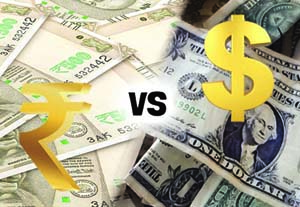
Kazi Zahidul Hasan :
The current ‘free fall’ of Indian rupee against the US dollar will benefit Bangladesh’s imports while its exports to face greater challenges in the Indian market, say economists and businessmen on Monday.
They also said that the fall in rupee against the greenback will boost Bangladesh’s import from India and consequently it may widen its trade deficit with India further.
The value of Indian rupee has fallen around 15 per cent against the surging dollar this year, making it one of the world’s worst performing currencies, according to Indian media reports.
“Falling rupee will erode competitiveness of local merchandises and subsequently it will hurt Bangladesh’s exports to India,” Dr Zahid Hussain, Lead Economist, World Bank’s Bangladesh office, told The New Nation yesterday.
India is the second largest trade partner for Bangladesh after China and the two-way trade between the two countries touched US$ 9.49 billion in the last fiscal year (2017-18). During the period, Bangladesh’s import from India reached US$ 8.61 billion while export stood at US$873 million, recording a trade deficit of US$7.74 billion. “A weaker rupee makes import expensive for India while exports cheaper in dollar terms. Indian exports to Bangladesh will fuel if the rupee continues to fall and it will therefore push up trade imbalance between the two countries further,” said Dr Zahid Hussain. He observed that Bangladesh’s exports to India remained low and was confined to limited items despite India grants duty-free market access to local merchandises. It is yet to exploit the facility due to lack of export diversification. Bangladesh exports goods including raw jute, jute goods, frozen food, agri-products, woven garments, knitwear, leather and chemical products while imports goods including automobile, textiles and textile articles, products of the chemical or allied industries, machinery and mechanical appliances.
“Depreciated rupee has added an extra advantage to Indian manufacturers while exporting common products like garments, shrimp and jute to third countries. This will definitely cause diversion of trade from Bangladesh,” M Shafiul Islam Mohiuddin, President of the Federation of Bangladesh Chambers of Commerce and Industry (FBCCI) told The New Nation yesterday. He also said that India is a key competitor of Bangladesh in global garments export and both the countries compete for same markets. Fall in exchange rate of rupee made Indian apparel items more competitive. It will cause reduction in Bangladesh’s share of global export orders by diverting those to India. “But the silver lining is that we can save over $1.2 billion, which is 15 per cent of our total import from India. Bangladesh could be benefitted immensely from cheaper Indian import while turning them to value added products for exports,” said Mohiuddin. “The fall in value of Indian currency can be both negative and positive for local economy when India remains Bangladesh’s second largest trading partner,” Dr Ahsan H Mansur, Executive Director of Policy Research Institute (PRI) told The New Nation. He said falling exchange rate of rupee against dollar has become a ‘boon’ for importers while bane for exporters as the situation makes import cheaper while exports less competitive. “But the situation may be short-lived as the Indian currency is expected to rebound any time,” he added.
Indian rupee on Monday traded around 74.05 per dollar. The Indian currency touched a record low of 74.22 per dollar on Friday, according to Indian media reports.

